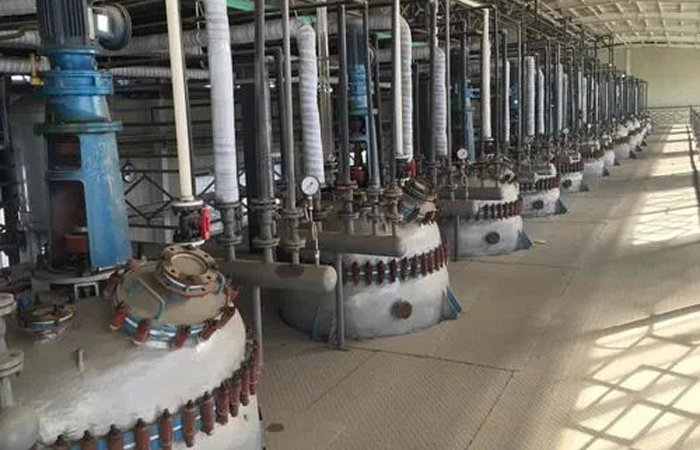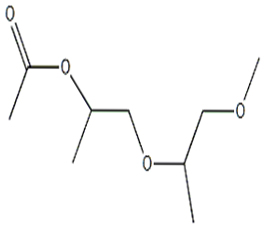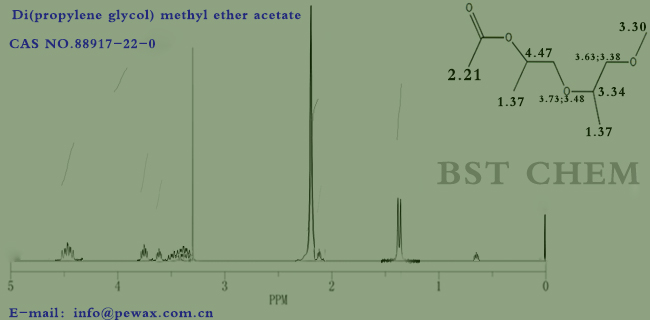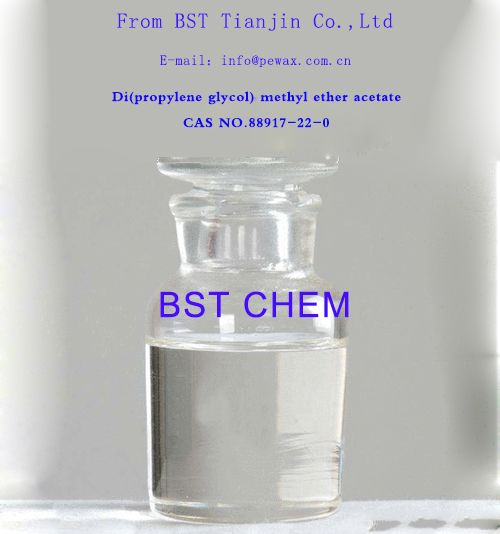Di(propylene glycol) methyl ether acetate
If you want to buy the chemical ,please inquiry us through E-mail: chem@pewax.com.cn
Can you hope know the supplier status though its pictures ?

First of all,
What is the basic information of the chemical ?
|
CAS Number |
88917-22-0 |
Vapor pressure |
0.0334mmHg at 25°C |
|
Density |
1.0±0.1 g/cm3 |
Flash Point |
91.1±20.4 °C |
|
Molecular Formula |
C9H18O4 |
Boiling Point |
229.8±15.0 °C at 760 mmHg |
|
MSDS |
Document |
Molecular Weight |
190.237 |

Second ,what is its MSDS that can show you how to handle it when using it ?
Whenever, safe is always in the first place,can you view the information below?
|
Personal Protective Equipment |
Eyeshields;full-face respirator (US);Gloves;multi-purpose combination respirator cartridge (US);type ABEK (EN14387) respirator filter |
|
Hazard Codes |
Xi: Irritant; |
|
Risk Phrases |
R36/37/38 |
|
Safety Phrases |
26-36 |
|
RIDADR |
NA 1993 / PGIII |
|
WGK Germany |
3 |
|
HS Code |
2942 0000.00 |
Third, how we can produce the chemical for your reference when you synthesis it in the future, are you interested in the good content?
If you want to buy the chemical ,please inquiry us through E-mail: chem@pewax.com.cn
Synthetic line:
There are three main chemical synthesis lines
First is as follows
Methanol air oxidation method
This method can obtain propylene glycol methyl ether acetate through methanol air oxidation reaction. The specific steps are: to oxidize methanol and air under the action of a catalyst to obtain acetaldehyde and formic acid, and then to react acetaldehyde with methanol to obtain propylene glycol methyl ether acetate.
Second is as follows
Methanol formic acid esterification method
involves first reacting methanol with formic acid to obtain methanol formate, and then reacting propylene glycol with methanol formate to obtain propylene glycol methyl ether acetate. The specific steps are: heating methanol and formic acid under the action of a catalyst to obtain methanol formate, and then reacting methanol formate and propylene glycol under appropriate temperature and catalyst to obtain propylene glycol methyl ether acetate.
Third is as follows
Methanol methylacetone esterification method
This method involves reacting methanol with methylacetone to obtain methanol methylacetone alcohol, and then reacting methanol methylacetone alcohol with acetic acid to obtain propylene glycol methyl ether acetate. The specific steps are as follows: reacting methanol and methylacetone under the action of a catalyst to obtain methanol methylacetone alcohol, and then reacting methanol methylacetone alcohol and acetic acid under appropriate temperature and catalyst to obtain propylene glycol methyl ether acetate
Besides, like other chemicals, it has synonym,do you want to futher know?
|
DPMA
1-[(1-Methoxy-2-propanyl)oxy]-2-propanyl acetate |
|
Di(propylene glycol) methyl ether acetate
UNII:5455FZE9RB |
|
2-Propanol, 1-(2-methoxy-1-methylethoxy)-, acetate |
Certainly ,do you concern about how you can identify the chemial is what you righ need or not?
And do you feel whether it is necessary for you test the sample from the batch befor you use it,using Professional equipment ? the anwer is no doubt “yes” these equipments are needed.
For instance,
Through the kinds of special spectrum as follows ,can you want to restore theem as follows?
If you want to buy the chemical ,please inquiry us through E-mail: chem@pewax.com.cn
Molecular structure data
Molecular Property Data:
1. Molar refractive index: 48.92
2. Molar volume (m3/mol): 194.0
3. Isometric volume (90.2K): 449.0
4. Surface tension (dyne/cm): 28.6
5. Dielectric constant: None available
6. Dipole distance (10-24cm3): No available
7. Polarization rate: 19.39
Computational Chemistry Data
1. Reference value for hydrophobic parameter calculation (XlogP): 1.2
2. Number of hydrogen bond donors: 0
3. Number of hydrogen bond receptors: 4
4. Number of rotatable chemical bonds: 8
5. Number of tautomers:
6. Topological molecular polarity surface area (TPSA): 44.8
7. Number of heavy atoms: 13
8. Surface charge: 0
9. Complexity: 136
10. Number of Isotope Atoms: 0
11. Determine the number of atomic structure centers: 0
12. Number of uncertain atomic structure centers: 1
13. Determine the number of chemical bond stereocenters: 0
14. Number of uncertain chemical bond stereocenters: 0
15. Number of covalent bond units: 1
A.standard HNMR as follows
if you want to get price, HPLC picture or other spectrumas, welcome e-mail us through info@pewax.com.cn
Will you hope the standard specification of the chemical in general?
The specification of UNII:5455FZE9RB is as follows
Appearacne: colorless clear liquid.
Color,% (Pt-Co): 20 max
Purity:99% min by GC
IR identity: conform
Water by KF: 0.05% max.
The product picture below
Of course,the most important thing is what are the usages of Di(propylene glycol) methyl ether acetate,do you
want to know?
If you want to buy the chemical ,please inquiry us through E-mail: chem@pewax.com.cn
Three three main sorts of usages as below
Firstly, dipropylene glycol methyl ether acetate plays an important role in the chemical industry. It can be used as a component of solvents, diluents, and adhesives, and is widely used in fields such as coatings, inks, adhesives, and plastic products. Due to its good solubility and stability, it has become an ideal choice for many chemical reactions and processes. In the chemical synthesis process, dipropylene glycol methyl ether acetate can serve as a carrier for the catalyst, improving reaction efficiency and product quality. At the same time, it can also be used for the production of surfactants, for the manufacture of products such as detergents, emulsifiers, and softeners.
Secondly, dipropylene glycol methyl ether acetate plays an important role in the pharmaceutical field. It has good permeability and stability, and has broad application prospects in drug delivery systems. By changing the physical and chemical properties of dipropylene glycol methyl ether acetate, the release rate and bioavailability of the drug can be regulated, thereby improving the therapeutic effect of the drug. At the same time, dipropylene glycol methyl ether acetate can also be used to prepare drug carriers and sustained-release particles for the construction of drug delivery and controlled release systems.
In addition, dipropylene glycol methyl ether acetate is also widely used in daily life. It can be used as a lubricant for the maintenance and upkeep of mechanical equipment and electronic products. Due to its low toxicity and biodegradability, dipropylene glycol methyl ether acetate can also be used in the production of personal care products and food packaging materials. In addition, it can also serve as a dispersant for dyes and pigments, used in fields such as textile, printing, and papermaking industries.
In summary, dipropylene glycol methyl ether acetate is a widely used organic compound. It is used as a solvent and adhesive component in the chemical industry, in the construction of drug delivery systems in the pharmaceutical field, and in the production of lubricants and personal care products in daily life. With the continuous progress of technology and increasing demand, it is believed that the application prospects of dipropylene glycol methyl ether acetate will be even broader
if you have known other new usages,welcome e-mail us through info@pewax.com.cn
we can disucss each other on such new fields.
If you want to buy the chemical ,please inquiry us through E-mail: chem@pewax.com.cn
Ultimately, articles cited as follows, for your reference,we do not know if you can get some helps from them then?
Related scientific Articles:
(1)Privacy Act Laws, Policies and Resources
(2)The challenge of using read-across within the EU REACH regulatory framework; how much uncertainty is too much? Dipropylene glycol methyl ether acetate, an exemplary case study




